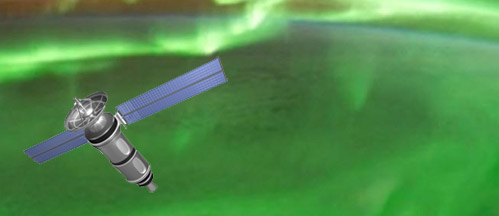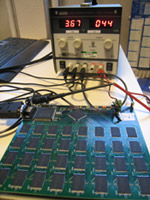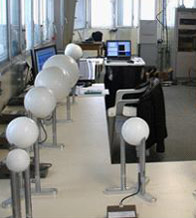Electronic components are subject to natural radiation that could harm them or create false information, especially at altitude. ONERA assesses the damage, to improve the reliability of satellites or aircraft.

A beautiful aurora borealis; it is also a terrible solar storm. The kind of risk that satellite manufacturers take into account as from the design
 Cascades of airborne particles generated from cosmic rays |
The Sun, without which life on Earth would not exist, does not only give us benefits. It also very high energy emits particles that create ionising radiation, especially at high altitudes. Satellites and aircraft are therefore particularly exposed to it. Also, this radiation has deleterious effects on electronic systems: it interacts with the circuits, creating an interference signal that disrupts the processing of information. Worse still, some radiation permanently damages power electronic components. It is therefore crucial to be able to predict the reliability of the components during their lifetime, especially when it comes to components that are essential for safety, for example in aircraft.
"This issue of failures induced by particles is well known by satellite and spacecraft manufacturers”, which must indicate the reliability of their equipment. True, a satellite has never been proven to have been damaged because of this, but flight anomalies are not uncommon. In addition, radiation effects also concern ground electronics, even though the environment is less aggressive. "However, with the miniaturisation of components, the sensitivity of circuits to radiation increases” says Sophie Duzellier, a researcher from ONERA’s Space Environment Department. This miniaturisation also involves decreasing the electronic circuit supply voltages. However, when voltages are lower, the signal is also weaker, so it is more easily disrupted by a transient signal from radiation.
![]()
High energy ionizing particle tracks in the imager of a CCD camera
(white dots and tracks)
The resistance of circuits to radiation has become even more crucial now that the electronics are becoming increasingly present in our lives: a modern car contains a large number of computers! Imagine the failure of one of them in functions related to security! True, there are ways to counter this, such as codes intended to correct most errors, but they complicate the software and can do nothing against the destructive effects affecting the power components.
 Electronic board whose function is to measure the singular effects in a memory plane (TIMA Cooperation) |
Electronic board whose function is to measure the singular effects in an émoire plane (TIMA Cooperation).
Sophie Duzellier’s team assesses the sensitivity of components to radiation, in order to predict their reliability. For this purpose, she predicts the probability of an event (false information or component failure) due to ionising particles, depending on the type of component, the circuit architecture and the radiation encountered during the component’s final application. Failures are first modelled and verified experimentally. A measurement platform located on the summit of the Pic du Midi in the Pyrenees also measures the natural atmospheric radiation.
|
|
"We can also predict the reliability of components during their design, even before they are made”, says the researcher. “Thus, if a manufacturer wishes to design a new circuit, we are able to predict how it will react to the irradiative phenomena”. Manufacturers can thus design optimised circuits that are at the same time strong, compact and energy efficient.
Cécile Michaut, science journalist







